VOL.50, NO. 3
All About Eve: Screens on Stages on Screens
Steve Benton (East Central University)
No critic of Ivo van Hove’s 2019 stage adaptation of All About Eve was more brutal than Ben Brantley of the New York Times, whose review, “‘All About Eve’ Gets the Vampire Treatment from Ivo van Hove,” condemned the play as a “vacuum;” an “enervated,” “exsanguinated,” “defeated,” “depleted,” “horror movie without a pulse;” and an “anemic spectacle . . . sleepwalking across the stage,” “on the edge of slipping into a coma.” In the mouths of van Hove’s cast, Brantley complained, the smart repartee of the classic 1950 film directed by Joseph Mankiewicz lands “with the thud of frivolous jokes at a funeral.”
Several critics1 who shared Brantley’s dim appraisal of the film-to-stage adaptation traced its lifelessness to the videos van Hove projected onto a big screen above the stage at various times throughout the mixed-media production (see Figure 1). Other van Hove productions that have used such projections have been widely praised by critics, including Brantley, who before dumping on All About Eve, had served up rave reviews of other van Hove productions, and described the Belgian director as “perhaps the most influential director of his generation in international theatre” (“Review: Shakespeare’s Take on the Game of Thrones”). One reason such projections have been successful, van Hove has explained, is that they “bring the emotional life of the characters closer to the audience” (Bennett and Massai 7). But for many unhappy critics of van Hove’s All About Eve, the big screen projections had the opposite effect, distancing audiences from the emotional lives of the characters rather than bringing them closer.
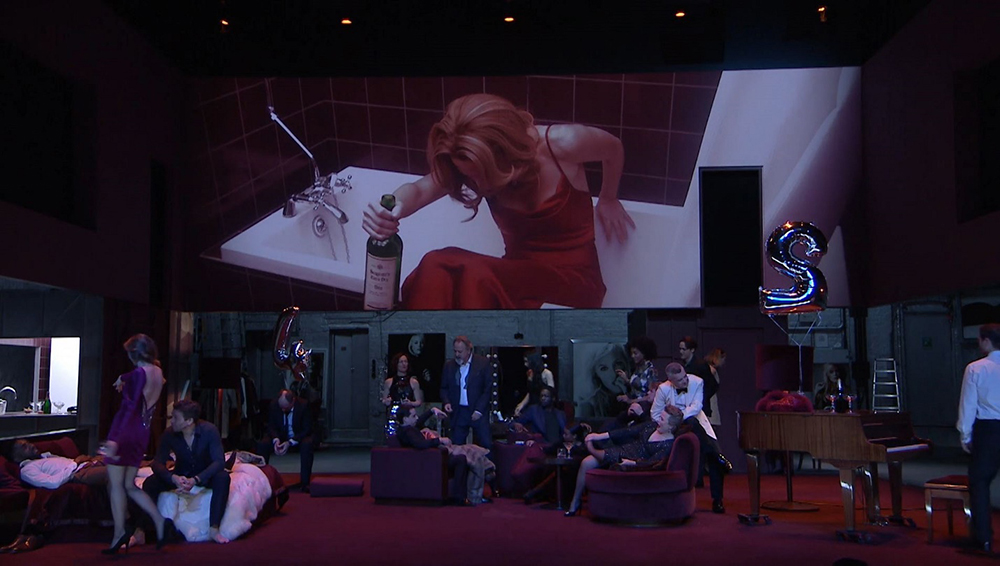
After opening his review of van Hove’s All About Eve with the withering warning—“Fasten your seatbelts, it’s going to be a boring night”—Dominic Maxwell of The Times (London) explained that “the mixture of stage acting and sequences filmed and projected onto a big screen upstage drains the energy from the action.” Under the headline “It’s All About Gimmicks,” Quinton Letts, of the Daily Mail, described the video projections as “distracting,” and suggested that they rendered the production “bloodless,” leaving him unsure if he “cared remotely about the characters.” Michael Billington, of The Guardian, characterized the production as a “clever, mixed-media hybrid” but also found that it was, perhaps, “too clever for its own good,” partly because he found himself “admiring its cleverness more than relishing its drama.” Writing for the Hollywood Reporter, Demetrios Matheou argued that “beaming live images onto the screen, provides the evening's most stultifying moments,” and in an otherwise positive review, Gay Times writer Chris Selman shared how moments relayed to the audience “via the camera” created “a bit of a disconnect between the audience and what was happening on stage.”
These charges—that the mixed-media dampened the emotional impact of the drama—strike at the core of the van Hove brand and its close association with emotional provocation and a tradition that traces its roots back to Antonin Artaud. According to van Hove, of the three primary 20th century theorists the Belgian director studied at the Brussels directors’ academy—Artaud, Brecht, and Stanislavsky—it was Artaud that van Hove took “as his inspiration” (Willinger 13). After quoting from Artaud’s The Theatre and Its Double—“Theatre should wake us up—should wake up our heart and our nerves” - van Hove tells interviewer David Willinger that “Artaud considered theatre to be a visceral thing, a physical thing. And this is still what I’m trying to do. Theatre was meant to be a living, important urgent thing” (13). Sadly, “living” and “urgent” are not terms that theatre critics used to characterize van Hove’s All About Eve.
But these critiques notwithstanding, I will argue here that the mixed media elements in All About Eve were never more aptly deployed. The live feed video projections and the subsequent multimedia adaptations of the production may have dampened the drama’s emotional impact. But they also helped sharpen thematic tensions between theatre and cinema and differing models of audience engagement: enrapt emotional engagement and alienated critical analysis. These tensions are not extraneous to All About Eve but deeply rooted in it. Bringing these tensions to the attention of the audience enriches this adaptation.
Again with the On-Stage Screens?
For many years, van Hove has used on-stage cameras, live feeds, and video projections for diverse purposes: to amplify the emotions of individual characters; to illustrate mental states and external contexts in a more metaphorical sense; and to offer audiences a complex array of perspectives on characters, setting, and actions. Willinger reports that van Hove’s 1996 production of Albert Camus’s Caligula was the first in which the Belgian director used an “onstage cameraman, giant camera slung over his shoulder in plain sight, filming a live feed, and apt to go right up into the face of the live actor playing Caligula” (73). In time, van Hove’s productions became known for having a “plethora of monitors and video screens littering and hanging over the stage” (Willinger 72).
In Caligula, an on-stage screen served as a tool to enhance the stage performer’s power, allowing the emperor, a “giant on the screen,” to address the audience “seductively and intimately” (Willinger 73). In Kings of War (2015), meanwhile, videos allowed “close-ups of the actors” so that “no matter how remote they are from us, the spectators, they are intensely present,” providing looks that are “stronger than any monologue could be” (Thielemans 298). As van Hove himself has put it, big screen live feed video projections of individual actors’ faces function like the masks used in Greek tragedies, which are, as he has described them, “huge close-ups of an emotion” (Willinger 72). In other productions, van Hove has used on-stage screens to offer audiences more metaphorical access to the mental and emotional worlds of certain characters. In Cries and Whispers (2009), for example, the main character’s troubled sleep is represented by “snatches of frenetic cartoons of Tweety Bird, flashing faces, and high speed, abstract patterns that whizz across the video screens” (Willinger 189). In Ludwig (2011), images on a giant video screen “seem to visualize Ludwig’s deteriorating, short-circuited brain” (Willinger 203). And in Kings of War (2015), big screen close-ups of the actors were complemented by “various small monitors [that flickered] with short-circuiting imagery . . . to evoke a state between sleep and wake” (Willinger 76).
Sometimes van Hove uses videos projected onto on-stage screens to offer audiences a “simultaneous and multi-perspectival approach” to the characters and their worlds (Willinger 72). In a 2010 production of Maxim Gorky’s Children of the Sun, for example, van Hove used “outsized video images depicting global horrors” to depict “the disorganized immensity lurking within or outside . . . the homes he and [set designer Jan] Versweyweld erect onstage” (Willinger 52). In Edward II (2012), the screen above the stage “simultaneously displays many different images as it projects a live feed of various parts of the stage—mostly peering into discrete cell units to reveal intimate moments within them from angles the audience can’t access from the front” (Willinger 204). And in The Antonioni Project (2009), both live and pre-recorded video feeds projected onto various on-stage screens, large and small, “don’t necessarily display the same images as each other, which makes for two perspectives at any given time at a minimum” (Willinger 75). The result is that the production offers audiences “subjective, creative, and global” points of view “altogether and simultaneously” (Goriely 259). Consequently, “even though the spectators are sitting in the audience, from one visual point of view, their position in relation to the representation is in perpetual movement” (Goriely 260).
In some of these productions, the camera operators themselves are characters who shape the experience of the performers. In The Antonioni Project, for example, one of the characters is, herself, a performance and video artist, and she controls one of the three roving handheld cameras, offering audiences “greater access to her subjective self” (Goriely 259). In Edward II (2012), a technician sits in a tall rectangular tower on the stage and appears to be operating the production’s sound, light, and video that is projected onto a “screen hanging over the stage . . . akin to the multiple, split-screen monitors with which department stores, grocery stores, and office buildings survey many locales at once, so that any malefactors can be captured” (Willinger 204). When a riot breaks out in the prison where the characters are all held, “the video camera picks up on the technician in the tower, his image magnified, viewed in an aerial shot, adjusting his dials and eating a big salad with consummate detachment” (Willinger 205). In van Hove’s 2006 film-to-stage adaptation of John Cassavetes’s 1977 film Opening Night, which was itself inspired by Mankiewicz’s original film version of All About Eve, van Hove effectively uses on-stage video camera operators transmitting live feed images to on-stage screens to convey the emotional drama swirling around the main character, Myrtle. These pushy camera operators don’t simply record the emotional drama; they help produce it, as their “cameras constantly follow Myrtle around as impolitely as possible, capturing and seeing into and through her body and to an even greater degree her face, and projecting that image onto several screens, the largest of which dominates the stage” (Goriely 261).
In the best of these productions, the on-stage cameras, live feeds, and video projections help develop themes that are central to their respective dramas. Brantley may not have seen much thematic value in the above-stage screens in All About Eve, but he claimed that in van Hove’s Opening Night, the multiple live video feeds serve as “much more than a gimmick” (“A Natural Cassavetes Woman, Naturalized, Magnified, and Multiplied”). According to Brantley, the multiple live feeds produce a “plethora of simultaneous versions of the same scene,” and the overall effect “suits well the portrayal of people whose sense of self is forever in flux” and helpfully contributes to the intended “disorientation” of the audience (“A Natural Cassavetes Woman”). In fact, throughout his career, van Hove has deployed on-stage cameras, live feeds, and video projections to help draw out a wide range of thematic concerns from the desacralization of the modern world, to the porosity of public and private worlds, to social alienation and the dissatisfying artificiality of relationships, and the constructed nature of our perspectives. In many of these productions, “functional monitors and laptops” that “tend to stay turned on as background noise and image between the stage action” suggest that “in the modern world, the role of sanctified repository for contemporary civilization’s pulse has been transferred to the electrified screen” (Willinger 118). In Roman Tragedies (2007), meanwhile, the live feed videos produced by camera operators circulating throughout the action, filming both actors and audience members, help problematize “the public and private lives of political figures in a world that feels like today” (Willinger 75). In The Antonioni Project the tension between different perspectives offered by the various live feeds help create a relationship atmosphere that is “charged with alienation and incommunicability” (Goriely 261). Because the performers are “always under the scrutiny of a camera” that invades “spaces that are so private, they aren’t even available to the audience’s gaze any other way,” the production exposes “the artificiality of relationships—behind the ‘mask of bourgeois well-being’” (Willinger 194, 192). The use of multiple, live feed video projections in this production also wittily directs viewers’ attention from the specific content of the three stories of the films that inspired the project and more to “the art of making narratives in general” and “how the stories are being transmitted” (Willinger 75-76).
For those who have seen multiple van Hove productions, there is a risk that this attention to “how the stories are being transmitted” can become a distraction rather than an enhancement. Willinger notes that as early as 2010, Dutch critic Hein Janssen felt confident in itemizing the “tried and true ingredients in the theatre of van Hove and his permanent designer Jan Versweyweld,” which included “an off-white wall with a video screen, a shiny floor, glass walls everywhere, 25 half-lit fluorescent lighting instruments, and a ubiquitous cameraman” (Willinger 119). In time, some of the van Hove moves that once “fascinated” critics and audiences began to “pall when reiterated once too often or applied too clumsily” (Willinger 120). When the work seems “recycled,” as Henry Hitchings of the Evening Standard observed in a dismal review of Obsession, van Hove’s 2018 National Theatre film-to-stage adaptation of Visconti’s 1943 film, Ossessione, critics and audiences who were “formerly amazed” by the van Hove experience begin to find it stultifying (Willinger 120). Characterizing the critical backlash as a “honeymoon gone sour,” Willinger, himself, wonders whether “van Hove is simply applying his system too mechanically to each successive project, or that it has consolidated into a recognizable system and is yielding diminishing returns in dramatic surprise, and therefore power” (121).
Cinema vs. Theatre
Theatre critics who feel they have seen all of van Hove’s technical tricks before may be less inclined to find value in the connections between his mixed media stagecraft and the specific thematic tensions of a new production. But audiences less familiar with van Hove’s work may be better equipped to appreciate how uniquely suited these mixed media tools are to tease out a vital theme embedded in Mankiewicz’s All About Eve screenplay: the cultural anxieties about the status of the theatre in a world going cinematic. In that screenplay, which van Hove used as his stage script, Margo Channing, the aging star of the stage, played by Gillian Anderson, first gives voice to these anxieties when she gets into a shouting match with Bill, her director and lover, played by Julian Ovenden. When Margo expresses her fear that Bill may be seduced by some “glamourpuss” when he goes on a trip to Hollywood, she is worried, on one level, that Bill may fall in love with a younger woman. But on another level her anxiety is about the possibility that Bill will find himself unable to resist the allure of the cinema, a medium which offers directors greater control than theatre does and may be less interested in the older actress Margo is becoming.
The scene in which Margo expresses her anxieties that Bill will be seduced by Hollywood follows another in which Bill gives Margo’s young assistant Eve Harrington (Lily James), a long, scolding lecture about how foolish it is to idealize the “thea-tah” (pronounced by Ovenden with affectation). And in Margo’s first scene, van Hove gives Margo’s favored playwright, Lloyd Richards (Rhashan Stone), a telling line—one of the rare lines in van Hove’s production that are not included in Mankiewicz’s screenplay—in which Lloyd bitterly invokes Hollywood’s market power as he lashes out against Margo’s complaints about not having worthy new plays to perform. The “playwright’s problem,” Lloyd counters, is having to “borrow from Hollywood” actors who can, presumably, attract audiences for the roles they have written.
The power of Hollywood to eclipse Broadway is alluded to again when Bill comes back from Hollywood to celebrate his birthday in New York. Audiences learn that an unseen “Hollywood star” arrives after Bill does and leaves her beautiful fur coat with Eve. Earlier, Eve held one of Margo’s costumes up against her body and fantasized about wearing it while bowing before an imagined theatre audience (see Figure 2); now, however, it is the Hollywood star’s fur coat that has become the symbol of Eve’s fantasies (see Figure 3). In this scene, audiences are encouraged to see Eve not just as a younger version of Margo, preparing herself to succeed in Margo’s place, but as an actress more likely to attract interest from Hollywood film directors. In short order, Eve, who had earlier presented herself as a devotee of the “thea-tah,” is on her way to becoming the Hollywood glamourpuss trying to seduce Bill.
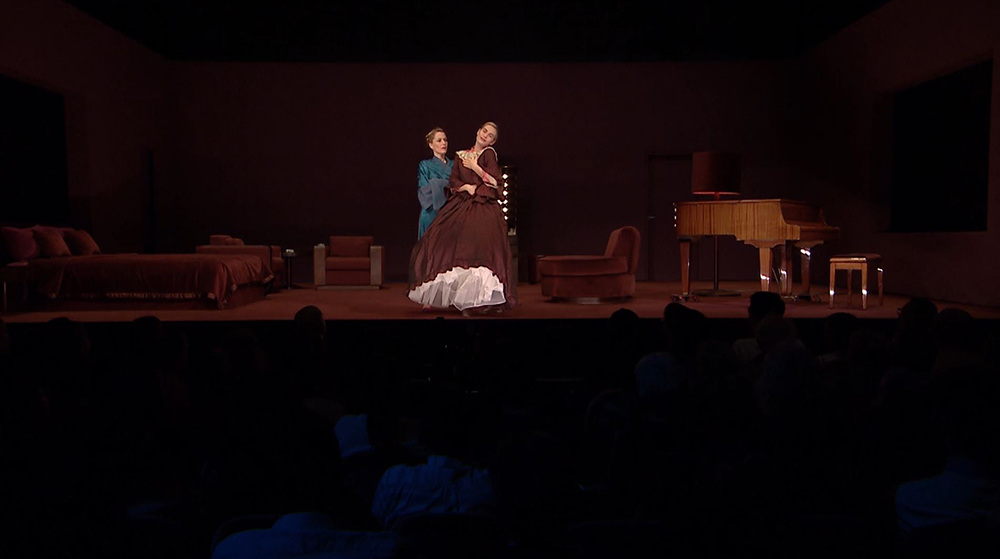
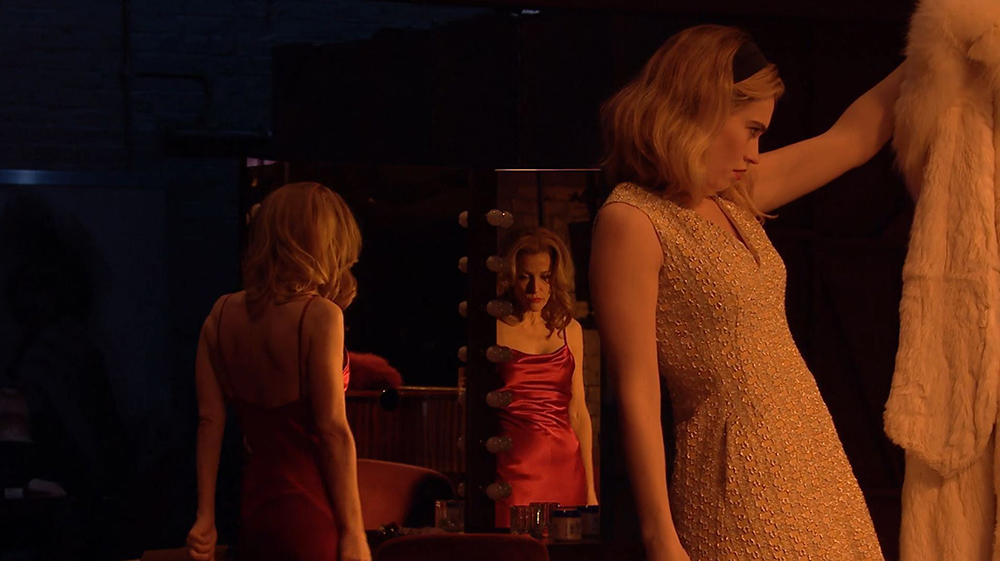
As a stage adaptation of an iconic film, van Hove’s All About Eve inevitably invokes theatre/film comparisons, but it drills down into these comparisons in other ways as well: making set design references to another film that was inspired by Mankiewicz’s classic; surrounding the stage with glamour shots of an ageless, timeless Margo that are gradually replaced by photos of her younger rival, Eve; having video camera operators on stage, capturing live feed videos that are projected onto the screen above the stage; and developing the screen above the stage as a character. At times, the screen is alone on the stage; at other times, it upstages the performances of the live actors below it; and at other times, it is afforded agency, functioning not as a tool that merely reflects the performances of the actors but as a character in its own right, who manipulates and comments on those performances for its own distinct purposes.
At the most obvious level of theatre/film comparison, the performers in van Hove’s stage production are competing with the performances featured in the classic 1950 film directed by Joseph Mankiewicz (see figures 4 and 5). In 2020, Victoria Lowe reported that over van Hove’s previous 38-year career, he had directed twenty stage adaptations of films (48). But as Lowe notes, most of these had been “adaptations of art house films from well-known European and American avant-garde directors, such as Ingmar Bergman, Michelangelo Antonioni and John Cassavetes” (48). Alongside these choices, All About Eve is a departure from the norm. The popularity of the original film, featuring Bette Davis in a legendary performance, may have proved useful in attracting attention from a marketing perspective, but the choice also presented new challenges to the production and to leading actress Gillian Anderson in particular. Just as the video screen literally hovers over the theatre stage, Bette Davis’s performance as Margo hovers virtually over Anderson’s performance, and many critics complained that Anderson did not come off well in the comparison.2 As Thomas Leitch has noted, audiences for film adaptations of literary texts are “constrained to hear [a character’s lines] . . . in exactly the way the performers are delivering them” (154), regardless of the way readers may have imagined those lines in their own heads when reading the original texts. But audiences of stage adaptations of films like All About Eve have a much more vivid alternative for comparison. The contrast between Bette Davis’s chilling delivery of the best-known line from the original film—“Fasten your seatbelts, it’s going to be a bumpy night”—and Anderson’s more slurred reading of the same line, is emblematic of the tension between the performance of a would-be usurper and the performance of an established star, which is itself mirrored in the rivalry between Margo and Eve.
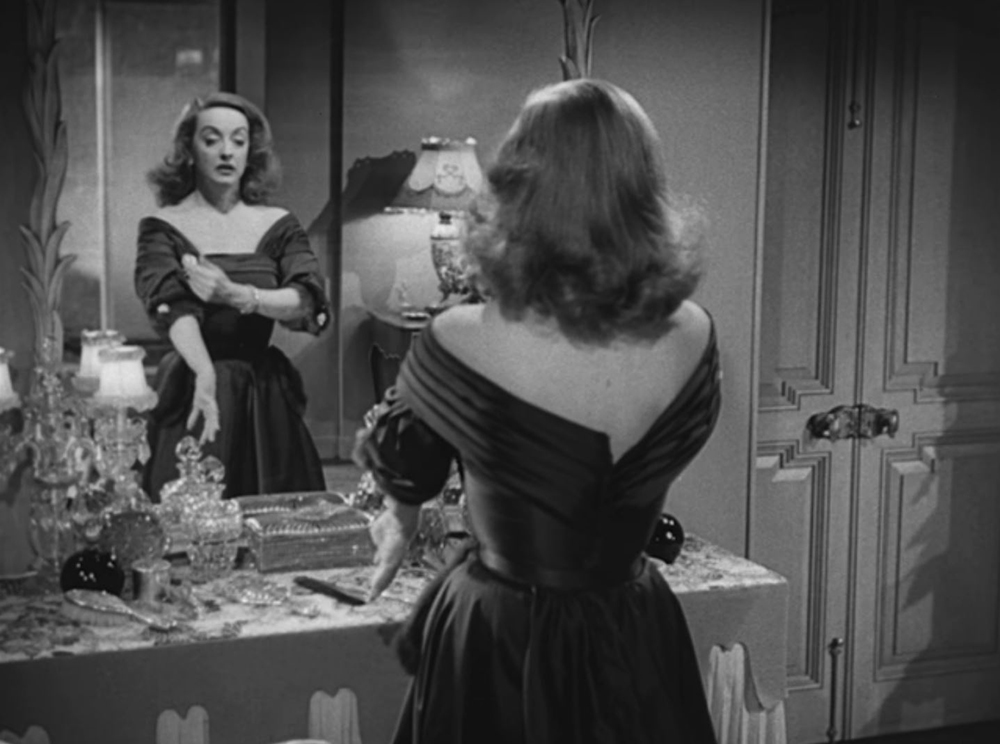

Mankiewicz’s All About Eve is not the only film that hovers over van Hove’s stage production, either. As Leitch, again, argues, it is a mistake to assume that “Adaptations are adapting exactly one text apiece” (164). In fact, “each individual adaptation invokes many precursor texts besides the one whose title it usually borrows” (164). With van Hove’s All About Eve, it is not just the Mankiewicz precursor but a successor film that is invoked. As viewers learn in the short documentary that introduces the National Theatre Live cinemacast, van Hove’s interest in All About Eve came to him through John Cassavetes’s 1977 film, Opening Night, whose screenplay van Hove adapted for the stage in 2008. In Opening Night, Myrtle, the Margo analog played by Gena Rowlands, is haunted by a fan who, like Eve Harrington in All About Eve, professes to adore the celebrated stage actress. In Cassavetes’s film, the young fan is killed in a car accident in the first reel, but the fan (or her ghost?) returns to haunt Myrtle and pushes her to the point of a nervous breakdown. One obvious interpretation of this haunting is that the ghost is a projection of the self-hatred Myrtle feels as she begins to age into older roles.
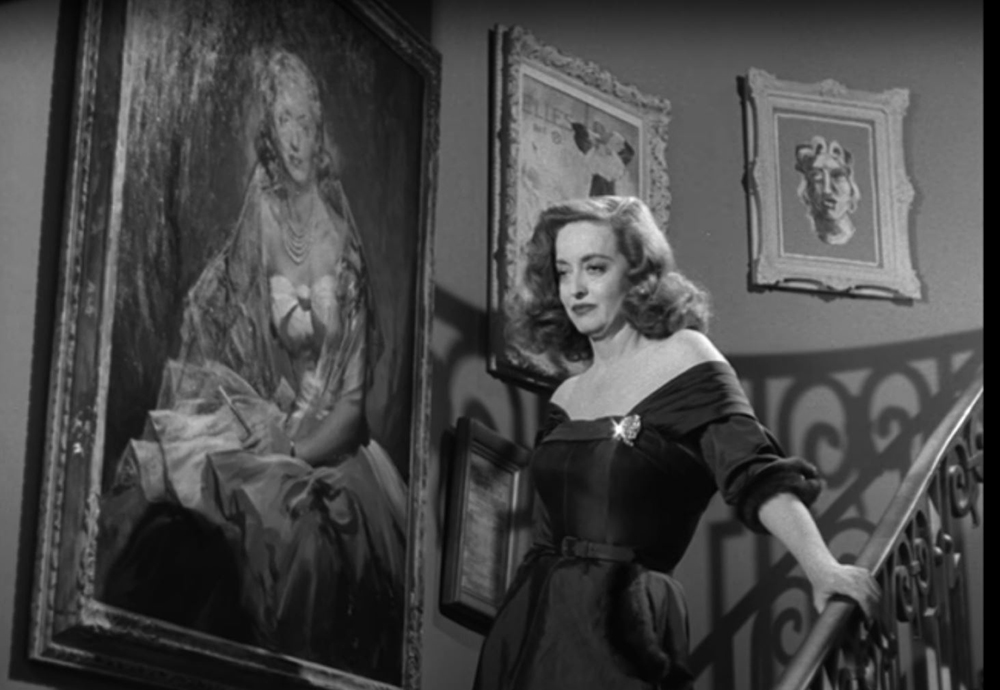
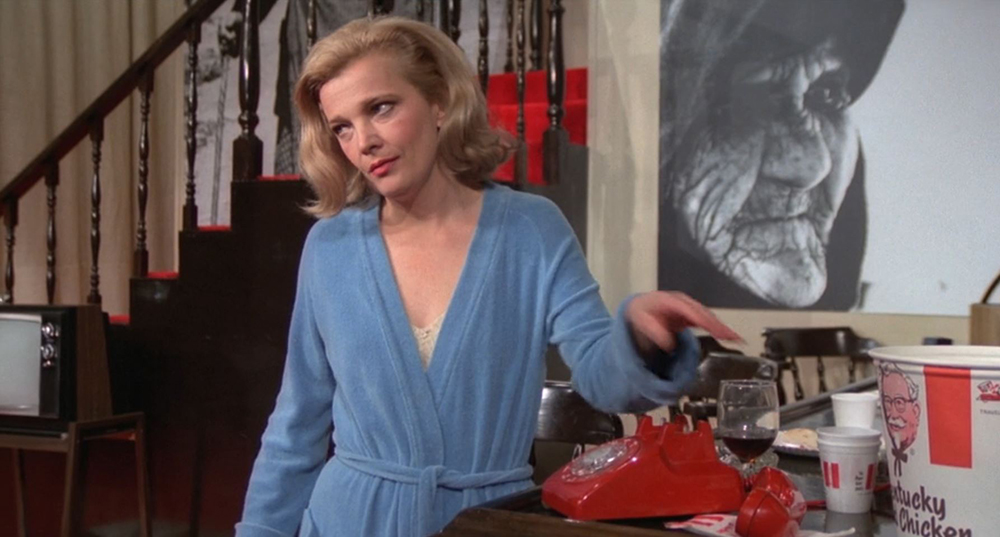
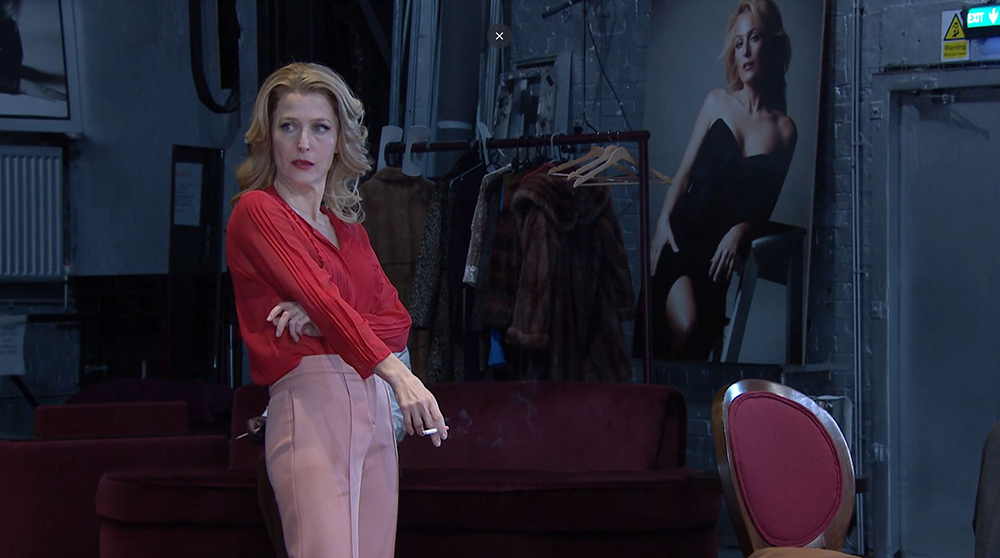
Viewers familiar with Opening Night may very well note how Cassavetes’s film haunts Jan Versweyweld’s set design for Van Hove’s stage adaptation, especially in the way it calls attention to the role age plays in the emotional life of his leading lady. In Opening Night, Myrtle’s fear of aging is dramatized by the set design of a play within the play Myrtle is performing in: an apartment that Myrtle’s character shares with her photographer husband. The apartment is dominated by giant, oversized photos of older, heavily wrinkled peasant women, which loom over the set (see Figures 7 and 9). Similarly, at the beginning van Hove’s production, many promotional shots of Margo line the backstage walls of the theatre (see Figure 10). Whether viewers recognize the allusions to Cassavetes’s work, these glamorous photos of Margo as a beautiful star, frozen in time (and subtly peering over the shoulder of the actors in artfully framed shots by cinemacast director Nick Wickham), subtly remind viewers of the many ways Margo is under threat—from an idealized younger self commemorated in the glamour shots, from Bette Davis’s iconic performance as her cinematic alter ego, and in the screenplay itself, from Eve Harrington’s rising fame, for when Eve succeeds, a promotional photo of her goes up on the walls, replacing a photo of her increasingly superannuated mentor.
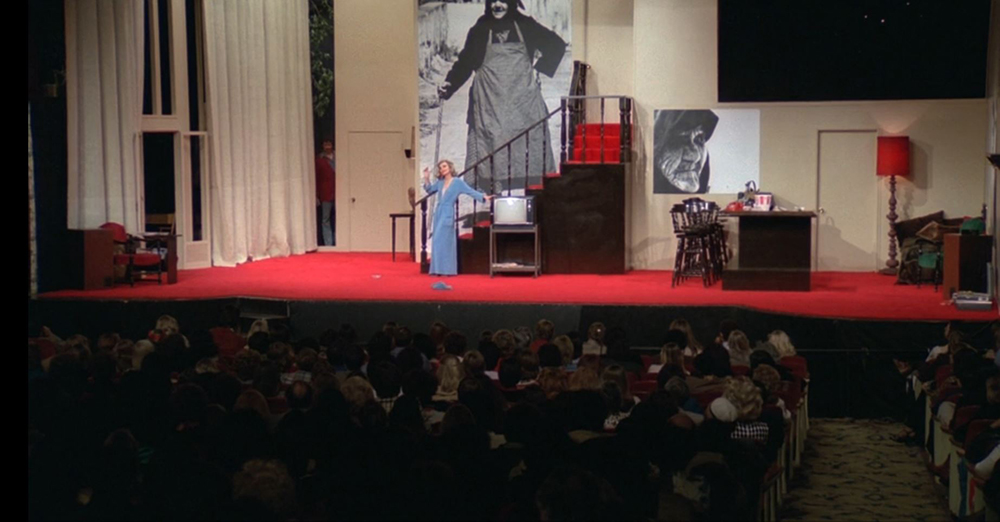
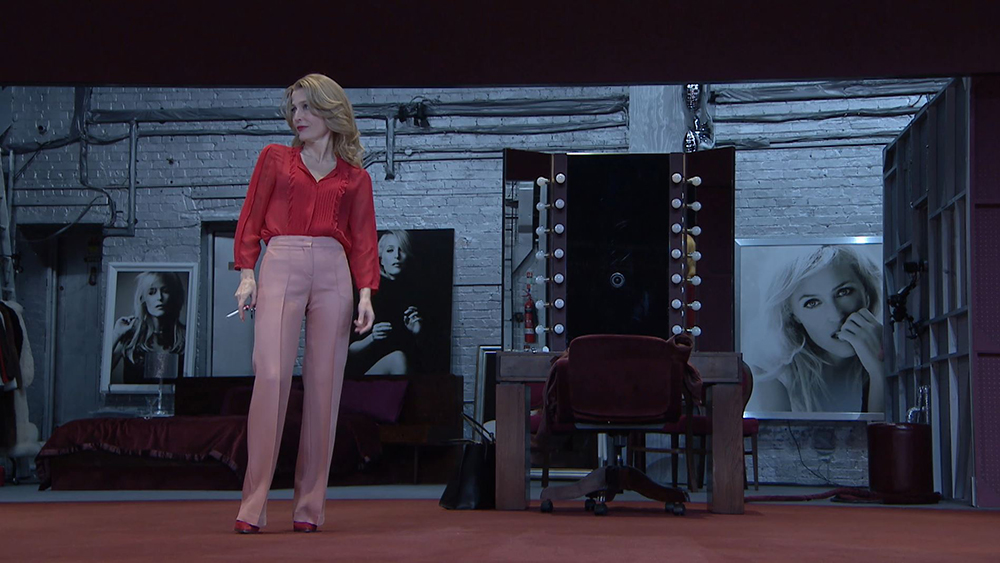
A more literal example of the tension between cinema and theatre is embodied in the video camera operators who walk onto the stage to record film footage that is livecast onto the big screen in the space above the stage (see Figure 11). On nights when the stage production is recorded by the National Theatre Live film crews for cinemacast screenings, film’s threat to theatre is even more pronounced, as some seats in the theatre go unused to allow space for the cameras and their operators and the very performances of the actors are likely adapted for close-ups. On these nights, audiences in the room where it happens may find several filters between them and the raw, unrecorded performance that has traditionally been the theatre’s domain, as they watch theatre cameras filming stage cameras filming stage actors performing for cinema audiences who will watch the whole production in other rooms at other times.

But the most obvious threat cinema presents to theatre in the production is a familiar van Hove touch: the panoramic screen that periodically dominates the space above the stage. Its prominence is emphasized from the first scene in the production, when the theatre critic and would-be narrator Addison DeWitt, played by Stanley Townsend, delivers his opening monologue, and the screen above the stage quickly becomes a focal point. Thirty seconds after Addison begins addressing the theatre audience, he is joined on the stage by a video camera operator whose live feed is projected onto the above-stage screen (Figure 11). Addison turns to address the camera and promptly walks off the stage, leaving it completely empty (see Figure 12). The camera operator follows him on a backstage tour reminiscent of segments now familiar in Saturday Night Live openings, where we see various stagehands and are visually introduced to the main characters in the production, a move that immediately compels the audience to shift their attention from stage to screen (see Figure 13). They don’t have much of an option. There is literally no one on the visible stage.
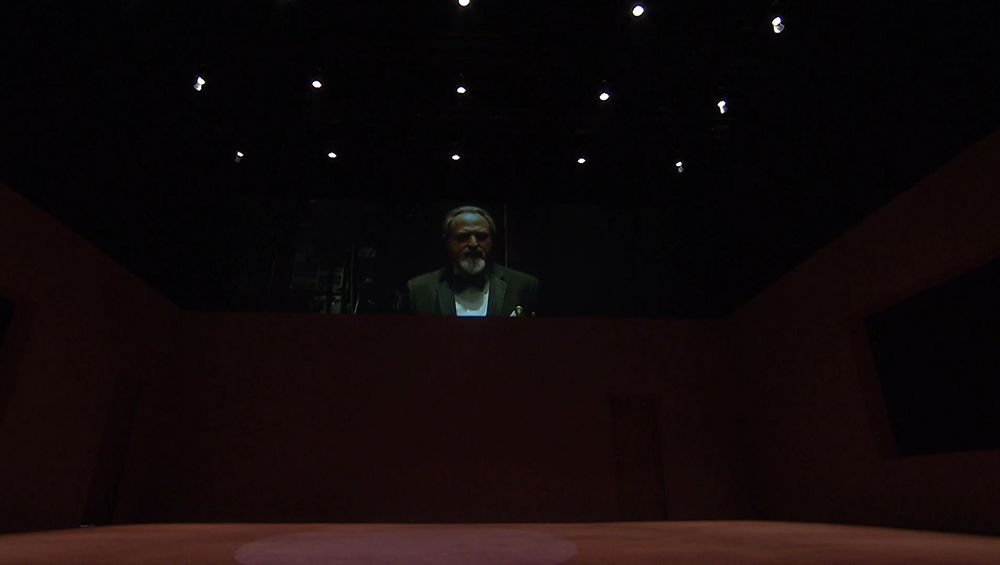
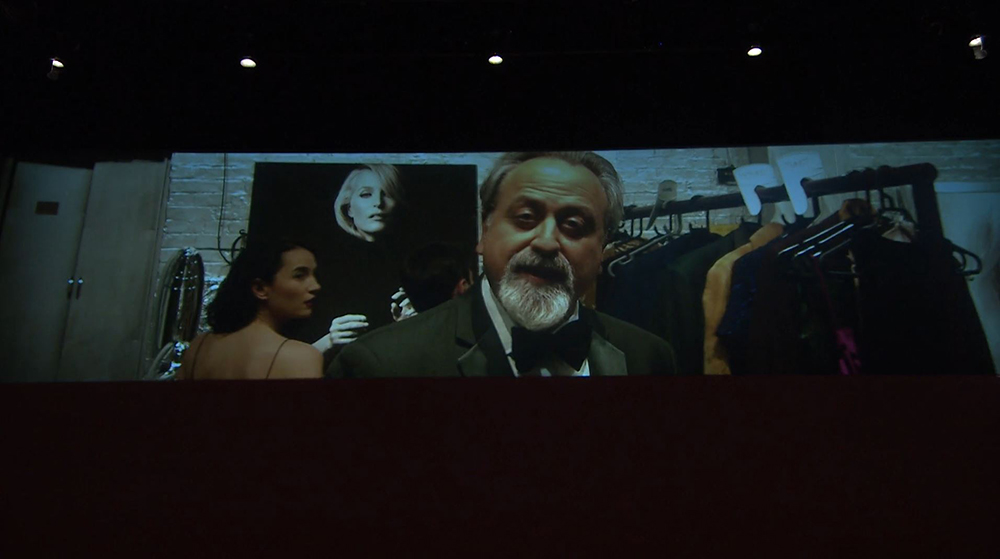
Throughout the production, theatre and cinemacast audiences will inevitably find their gaze drawn to the images on the above-stage screen and away from the actors on the stage, like spectators in a sports arena dominated by a Jumbotron offering a close-up view of gameplay that would otherwise be invisible to those sitting in the nosebleeds. The power of the projected images of actors on the video screen to attract attention away from the real actors on the stage brings to mind Eve’s description of her own experience playing “make-believe” so much as a child that she “couldn’t tell the real from the unreal, except for the unreal seemed more real” to her. As we have seen, for some critics of this production, these video images undermine the stage performers, but on a thematic level they are a physical token of the very temptation Margo fears the most: the threat that audiences will turn their attention from the performers on the stage to the images on the screen, from the old medium to the new, from her to her younger successors. It is, in short, not a bug, but a feature of the production.
The power of the video screen to assert its dominance over the stage performers is dramatized in multiple scenes in which Margo sits down with her back to the audience in front of the dressing room mirror she looks into when she applies and removes her makeup before and after each stage performance. A camera lens placed in the stage mirror creates a live video feed of her facial expressions as she reacts to other characters standing behind her, and this feed is projected onto the big screen above her (see Figure 14). But at one pivotal point in the drama, after Bill leaves Margo following an argument about whether Eve represents any kind of threat to their relationship, the live video feed in the mirror has been surreptitiously replaced by a recorded video. That video shows Margo’s face slowly aging (see Figure 15). As wrinkles and white hair overtake her image in the mirror, the actress begins to claw at a face that she fears is growing too old for close-ups or cinema. She screams before she is snapped out of the nightmare by her assistant, Birdie (Sheila Reid).
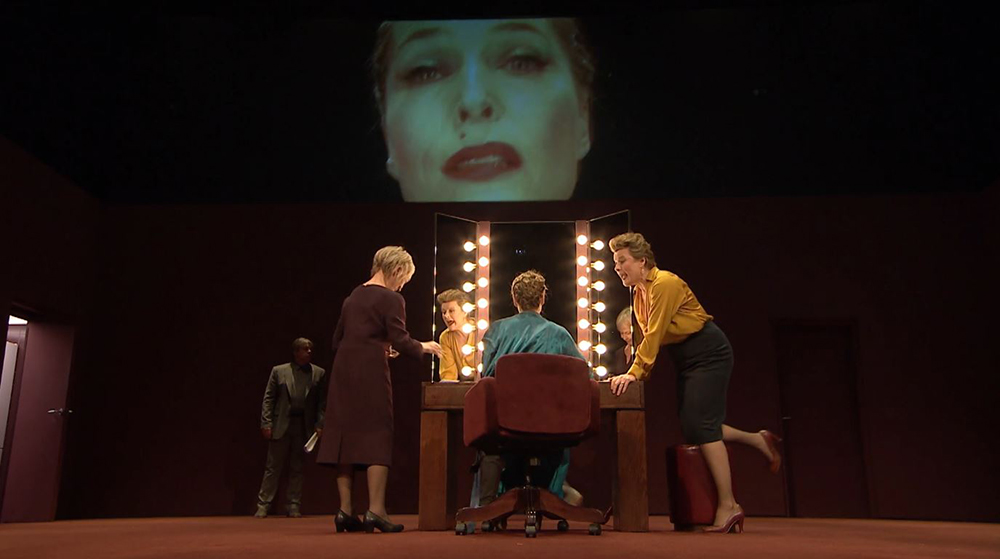
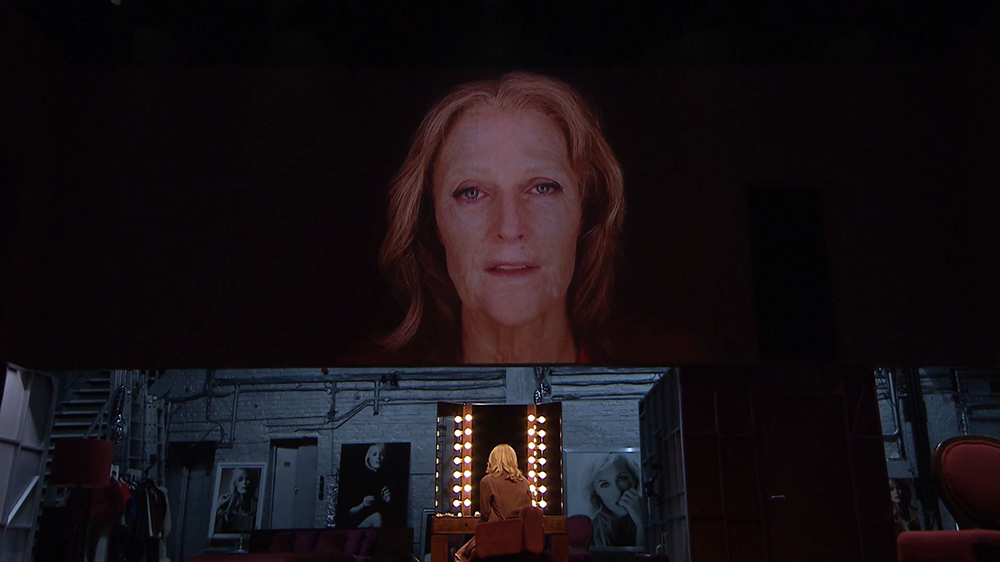
The screen’s development as a character with an agenda of its own is further revealed in a later scene, when a similar kind of special effect is used to dramatize Eve’s desire to usurp Margo’s place. When Eve sits down in front of Margo’s mirror, audiences watch the reflection of Eve’s face, projected onto the big screen, slowly morph into Margo’s. The transition reveals Eve’s ambition, but both this scene and the earlier scene depicting Margo’s fears also reveal the camera’s ability to transcend its presumed status as a mere reflective tool. Like the young ingenue, the camera can do more than gaze and reproduce captured images; it has agency. It can glorify one actor, and it can bring another down.
As a character, the screen more fully completes its transition from Margo’s ally to her nemesis during the party that Margo inaugurates with her famous “bumpy night” line. While her guests listen to a lively debate between Bill and Addison about whether theatre performers are a glorious “breed apart,” as Addison suggests, or whether they are, as Bill counters, simple technicians who work hard at their craft and receive too little recognition for their sacrifices, a drunken Margo retreats to the bathroom. Cameras behind the bathroom door project onto the big screen a video of Margo, with a bottle, tumbling into the bathtub, and then suddenly scrambling for the toilet (see Figure 1). From above, audiences watch as her body heaves, and then her head moves away from the toilet to reveal a vomit-covered bowl (see Figure 16). The video demonstrates the power of the big screen close-up to shock. It de-glamorizes Margo. And it also shows, perhaps, that the aging stage actress is not a good fit for a transition to Hollywood’s big screens, which love the young and unwrinkled.
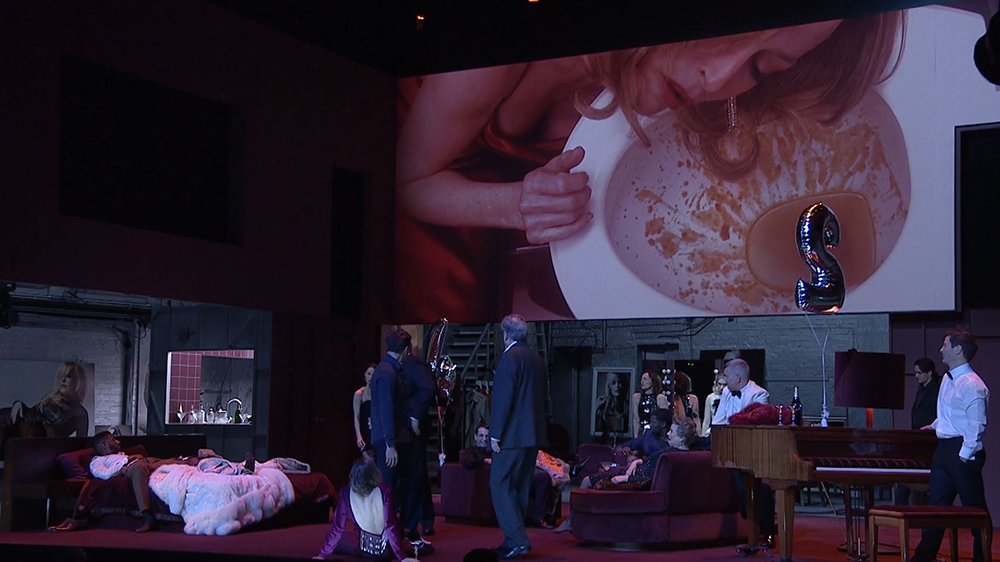
The vomit scene testifies to the power of the screen to draw attention away from the stage. But the screen’s limitations and dissatisfactions are subtly alluded to in the scene where Eve, at one of the first great pinnacles of her career, is given the Sarah Siddons award for distinguished achievement in the theatre. While Eve, the stage actresses, delivers her acceptance speech, a silent video feed is projected onto the screen above the stage. The video shows Eve delivering what appears to be the same lines, but the video feed and the live performance are not synchronous, and Eve’s facial expressions as she delivers the lines on stage are not identical to those in the pre-recorded video (see Figure 17). As such, the production presents audiences with two competing visual realities—stage Eve and pre-recorded video Eve—knowing that any discussion of which one of these is “real” must contend with the fact both are performances and neither shows the “real” ruthlessly ambitious Eve beneath her performance as a humble, gracious award winner. In this award ceremony scene, audiences are not encouraged to identify with either Eve. Both of them are alienated from the audience, as the theatre critics noted.
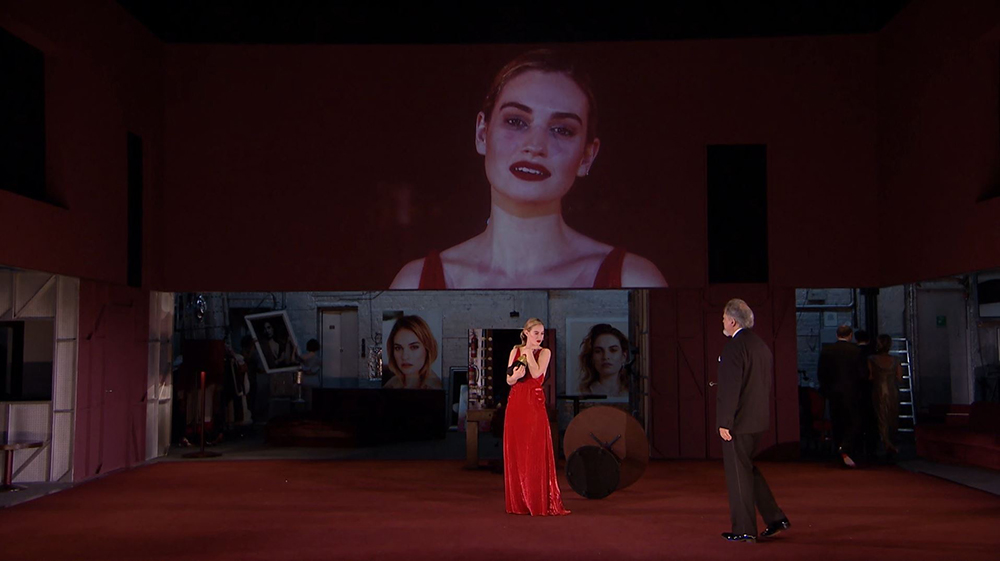
Stage Production, Cinemacast3, Streamcast
Since 2009, when National Theatre Live began screening its live-recorded productions in cinemas around the world, its marketing strategy has emphasized the near equivalency for audiences of the theatrical and the cinemacast experiences. National Theatre Live promises viewers “the best seats in the house” for “unedited” broadcasts (presumably requiring little from a film director) that are recorded in front of a live theatre audience with whom cinemacast audiences can share “every gasp, every laugh, every dramatic moment.” In the short documentary shown before screenings of All About Eve, it is stage director Ivo van Hove, not cinemacast director Nick Wickham, who is featured. And National Theatre Live’s Facebook page uses positive reviews of the theatrical performance to promote the cinemacasts. In the case of All About Eve, National Theatre Live cites a warm Time Out review that calls the production “absolutely one of those ‘I was there’ moments,” with no sense that far-flung cinemacast audiences will in anyway be denied the experience treasured by those who saw the production at the Noel Coward Theatre in London (National Theatre Live, “All About Eve is about our fascination of celebrity and youth”).
In a production like van Hove’s All About Eve, in which the tension between theatre and cinema is an integral part of the drama, National Theatre Live’s claims that its cinemacasts support and do not threaten National Theatre stage production merit closer inspection. It quickly becomes obvious that cinemacast director Nick Wickham makes myriad decisions about editing cuts and camera angles that significantly affect an audience’s viewing experience of the production. Wickham’s directorial power is evident from the first scene of the production, when Addison DeWitt leaves the stage to provide viewers with a backstage tour. As DeWitt continues his tour, the cinemacast camera slowly closes in on the above-stage screen until the stage floor is not visible and then closes in even further until the above-stage screen entirely occupies the cinemacast screen (see Figure 13). The effect renders the abandonment of the stage space less jarring to cinemacast audiences than it would be to theatre audiences.
Nick Wickham’s cinemacast direction complicates audience responses to theatre-stage tensions when DeWitt’s tour of the backstage area ends, and Wickham cuts from a close shot of the video screen to a wider shot that allows audiences to see the proportional relationship between the stage and the above-stage screen again. At this point, van Hove’s above-stage screen goes dark, temporarily surrendering the stage back to the performers. For a brief moment, the stage fills the cinemacast screen, but then, as in other scenes, Wickham’s cinemacast camera itself keeps lowering and widening its shot so that the stage itself becomes a kind of illuminated panorama in the physical theatre. The result is that it, too, looks like a screen above the audience, not a “real” alternative to a video simulacrum above the stage, but one video performance following another (see Figure 2 for a similar shot). The shot reminds cinemacast viewers of the many dizzying layers of performance that will be at play throughout this production of a stage adaptation of a film about the theatre, in which the stage performers compete with filmed images of themselves, in a production that is itself being filmed for cinema audiences. The result is less an invitation to identify with the characters and get lost in their emotional worlds, and more an inducement to take them and their relationships into perspective as performances, to see them, in other words, less as visceral, emoting animals and more as vessels that are manipulated to send messages. And in this sense, the cinemacast production makes it easier to see the screen above the stage as a character in its own right.
In Wickham’s cinemacast production, the screen above the stage—as a character—is less a scene-stealing omnipresent force than a member of an ensemble. Consider, for example, the first scene in which Margo’s image in the mirror is projected onto the screen above the stage. As long as this video feed is projected onto the screen, it is visible to theatre audiences, who are introduced to Margo as a giant, Oz-like head surrounded by smaller, dimmer characters reflected behind her in the mirror (see Figure 14). But for cinemacast audiences, Wickham often cuts the big screen out of the frame, allowing viewers to see Margo in more natural, human dimensions alongside other characters, of similar size, captured by cameras zoomed in more tightly from their position at a 45-degree angle to the stage (see Figure 18).
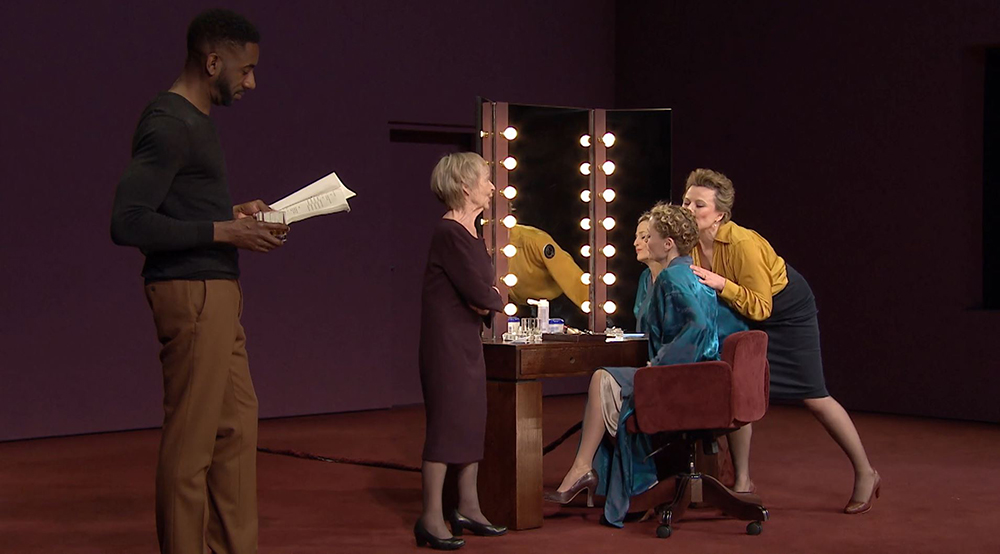
Similarly, while the video feed of Margo getting sick in the bathroom is always visible to theatre audiences, for cinemacast audiences, it is only in frame some of the time. When Wickham cuts to shots of the actors on the stage, it is, ironically, the cinemacast audience, watching the big screen, not the theatre audience, watching the live stage performance, that pays less attention to the screen-on-the-stage and more attention to the actors sharing the same physical space with the theatre goers. In these and other scenes, the cinemacast balances audience attention between stage and the screen-on-stage more nimbly than the theatre production itself does, which may explain in part why the theatre production dissatisfied so many critics of the stage production.
Though it may be less obvious than the differences between the viewing experiences of a live stage production and a cinemacast alternative, the viewing experience of National Theatre Live’s streamcast All About Eve will also be significantly different from the viewing experience of a cinemacast version of the production. These differences draw out other thematic tensions in Mankiewicz’s screenplay and present additional challenges to van Hove’s desire to produce theatre in the Artaudian tradition that is “living” and “urgent.”
For the first decade of its existence, the company line at National Theatre Live was that its productions had to be seen on cinemas. While a generation ago some live theatre venues were once “forced by economic reality” to post promotional banners that read “Not available on video,” as Philip Auslander has noted, National Theatre Live similarly imputed specificity to its productions by noting that its videos were only available in theatres and would not be released on DVD, Blu-ray or streaming services. This marketing strategy differentiated NT Live from other prestigious theatre companies such as the Royal Shakespeare Company and Shakespeare’s Globe, which produced recorded videos of their stage productions that they made available via a wide variety of media.
But in 2020, pandemic conditions forced National Theatre Live to join the streaming game. With the closing of theatres of all kinds around the world due to the global Coronavirus pandemic, National Theatre announced a new initiative in March of 2020 called “National Theatre at Home,” which streamed 16 different archive productions for free on YouTube, each for a one-week window. Nine months later, the National Theatre launched a subscription streaming platform that made selected productions “available online to watch anytime, anywhere worldwide” for anyone willing to pay the annual or monthly subscription services.
Perhaps the most obvious challenge faced by a streamcast of All About Eve is the reduction of the viewing screen to living room flat screens, laptops, or even cellphones. Simply put, size matters. It is difficult for audiences to appreciate the complex mise-en-scene that is a prominent feature of this cinemacast production when audiences are taking it in on a small screen. During the “bumpy night” party scene, for example, a silent crowd of guests gathers in the same kitchen, and cinemacast viewers can look at the screen-above-the-stage and see several different characters visually developing mini-narratives with their body language and facial expressions. Addison, the critic, looks for someone to control; the aspiring actress Claudia Caswell looks for someone to impress; Eve casts a sly side eye in Margo’s direction; Max, the producer, suffers heartburn; Karen tries to convince Bill to go out to Margo and reassure her of his affections. These details will be much less legible on a small screen than they would be in a cinemacast (see Figure 1 for a similarly complex mise-en-scene).
But an even more significant change to an audience’s experience of All About Eve as a streamcast rather than a cinemacast results from the reduction in urgency that comes from the conditions in which the production may be seen, both in terms of social context (isolated from other viewers) and time (with possible variations approaching infinity). Audiences at National Theatre Live cinemacast screenings had to be in the room with other viewers at a particular time on a particular day. The communal quality of National Theatre Live cinemacasts was often more important than their “liveness,” especially for audiences far from the United Kingdom, watching encore screenings at times more convenient in their respective time zones (see Barker 61-73). Seeing a National Theatre Live performance—even an encore performance—could seem more intensely ephemeral than a live theatre experience since an enthusiastic member of a live theatre audience might have an easier time managing repeat viewings of big budget theatre performance on an extended run than they would of seeing multiple screenings of an NT Live production, which are often only screened once at many cinemas. An audience member at a live performance of All About Eve or a National Theatre Live cinemacast of that production is presented with an ephemeral experience. Audiences of both productions are asked not just to attend the performance but to attend to it, with focus and concentration. In the YouTube iteration of National Theatre at Home, the most engaged audience members could at least use the comment boxes beneath the videos to create a lively community of discussion about the production during the limited time before each production was taken offline. For subscribers to the streaming service, however, there is at present no similarly convenient space for engaged audience members to interact with each other.
The streamcast All About Eve reduces urgency even further by giving individual audience members control of the play, pause, fast forward and rewind buttons. When Eve herself is manipulated and exploited by cunning theatre critic Addison DeWitt, Margo’s friend Karen tries to console her by pointing out that “Nothing is forever in the Theatre. Love or hate, success or failure—whatever it is, it’s here, it flares up and burns hot – and then it’s gone.” But this is not what happens with National Theatre at Home—where, as long as your subscription is paid and the service is viable, nothing is gone forever. This can be both a blessing and a curse. In one sense, the “At Home” experience empowers the viewer to become their own editor. Attentive streamcasters of National Theatre Live’s All About Eve can use the pause and rewind buttons to re-experience an especially compelling moment in the production. But audience members who go to the theatre or even the cinema may find themselves more emotionally engaged in a performance they have less control over, identifying with the characters, and empathizing with them. Meanwhile, the streamcast offers viewers the opportunity to use all the remote-control buttons at their disposal to analyze the production. The resulting audience experience might have been shunned by Artaud but endorsed by Brecht, who claimed he wanted to make the theatre less a sacred space of mystery and awe and more of a thinking space of increased consciousness, where audiences react to the performances, while puffing on cigars and shouting as if at a boxing match (8).
By pushing audiences closer to the Brechtian end of the Brechtian/Artaudian continuum between critical analysis and emotional provocation, the streamcast All About Eve effectively deepens awareness of two models of audience engagement embedded in Mankiewicz’s screenplay. The first is embodied in emotional, fan-girl Eve introduced to audiences at the beginning of the production. The second is embodied in the critical, ambitious actress Gertrude Slojinksy, who creates and performs the role of “Eve,” in order to get closer to the star of the stage she wants to replace.
Like a streamcast audience member with the power to play, pause, fast forward and rewind All About Eve at will, Gertrude/Eve attends every performance of “Aged in Wood,” the Broadway production Margo stars in at the beginning of the production. Gertrude (pretending to be “Eve”) watches it over and over, never missing an opportunity to rewind Margo’s performance and use it as a technical class in stagecraft and performance. In a sense, Gertrude self-administered the kind of magic-dispelling “alienation effect” that Brecht hoped to serve his theatrical audiences (91). Familiarity may breed contempt, but it may also breed acute perceptions. Along the way, Gertrude learns Margo’s lines and blocking by heart and comes to know the play so well, in fact, that she notices and complains when some of Margo’s colleagues “change everything around” after the director of the play leaves town. As “Eve” points out with some alarm to Margo, for example: “During your second act scene with your father, Roger Ferraday’s supposed to stay way upstage at the arch. [But] He’s been coming closer down every night . . .” These are not the observations of a star-struck fan, but the observation of a hard-working critical technician ready to take the stage herself.
In sum, then, the unhappy critics of van Hove’s All About Eve may have been right that the mixed media elements incorporated into the production muted its emotional force. In that respect, the production may not have lived up to van Hove’s stated ambition to create theatre that is a “visceral,” “physical,” and “urgent thing” in the tradition of Antonin Artaud. But the same mixed media elements sharpen All About Eve’s focus on the tension between theatre (which has more room for aging actresses) and cinema (which has less). Nick Wickham’s cinemacast direction effectively develops this focus. And while the streamcast production may be even less likely to provoke “visceral,” “physical” reactions in audiences, it also challenges the very claim that an emotional audience response is preferable to one that is more guarded and analytical and gives greater power to the audience member as “editor” and “author” of her experience. In short, the streamcast is a delivery system designed for a Gertrude.
Endnotes
1 In addition to Brantley (New York Times), Michael Billington (The Guardian), Quinton Letts (Daily Mail), Demetrios Matheou (Hollywood Reporter), whose reviews are mentioned below, other barbed reviews were submitted by Dominic Cavendish (The Telegraph), Henry Hitchings (Evening Standard), Natasha Tripney (The Stage), Matt Trueman (Variety), and, perhaps most memorably, Dominic Maxwell (The Times), whose pan opens with “Fasten your seatbelts, it’s going to be a boring night.”
2 A disappointed Michael Billington of The Guardian lamented that Anderson invests the main character “with a slow drawl and a pensive awareness of her own dispensability: she’s less of a testy termagant than Bette Davis but more vulnerable in the style of Tennessee Williams’s Blanche Dubois.” Billington adds that because of the decision to characterize Margo as a tragic figure who is less confident and glamorous than Davis’s Margo, “some of the zing and zap has gone out of the stage version.”
3 Throughout this essay, I will following Michael D. Friedman’s use of the term “cinemacast,” which as he notes, has been labeled in other places as “event cinema,” “livecast,” “cinema relay,” “outside broadcast,” “simulcast,” “streamed transmission,” “cinema livecast,” “beamed live performance,” “live cinema,” “digital broadcast cinema,” and “alternative content.” As Friedman rightly notes, the term “cinemacasts” includes artifacts that are not “simultaneously shown versions” of live stage productions (457). In venues many time zones removed from the United Kingdom, where National Theatre Live productions like All About Eve are staged, audiences increasingly experience “livecast” in delayed or much delayed “encore” formats.
Works Cited
All About Eve. Directed by Ivo van Hove and Nick Wickham, performances by Gillian Anderson, Monica Dolan, Lily James, Julian Ovenden, Sheila Reid, Rahshan Stone, and Stanley Townsend, National Theatre Live, 2019.
All About Eve. Directed by Joseph Mankiewicz, performances by Bette Davis, Celeste Holm, Anne Baxter, Gary Merrill, Hugh Marlowe, and George Sanders, Twentieth Century Fox, 1950.
Auslander, Philip. Liveness: Performance in a Mediatized Culture. Routledge, 2008.
Barker, Martin. Live to Your Local Cinema: The Remarkable Rise of Livecasting. Palgrave-Macmillan, 2012.
Bennett, Susan and Sonia Massai. Ivo van Hove: from Shakespeare to David Bowie. Methuen Drama, 2018.
Billington, Michael. “All About Eve review – classic Hollywood updated with technical wizardry.” The Guardian, 13 Feb. 2019, www.theguardian.com/stage/2019/feb/13/all-about-eve-review-classic-hollywood-updated-with-technical-wizardry>. Accessed 11 July 2021.
Brantley, Ben. “A Natural Cassavetes Woman, Theatricalized, Magnified and Multiplied.” The New York Times, 3 Dec. 2008, www.nytimes.com/2008/12/04/theatre/reviews/04opening.html. Accessed 4 Apr. 2022.
---. “Review: 'All About Eve' Gets the Vampire Treatment from Ivo Van Hove.” The New York Times, 13 Feb. 2019, www.nytimes.com/2019/02/13/theatre/all-about-eve-review.html. Accessed 11 July 2021.
---. “Review: Shakespeare’s Take on the Game of Thrones.” The New York Times, 4 Nov. 2016. www.nytimes.com/2016/11/05/theatre/review-shakespeares-take-on-the-game-of-thrones.html. Accessed 4 Apr. 2022.
Brecht, Bertolt, and John Willett. Brecht on Theatre: The Development of an Aesthetic. Hill and Wang, 1964.
Cavendish, Dominic. “All About Eve review, Noel Coward Theatre: Lily James lacks peculiarity in uninspired screen-to-stage affair.” The Telegraph, 12 Feb. 2019, www.telegraph.co.uk/theatre/what-to-see/eve-review-noel-coward-theatre-lily-james-lacks-peculiarity/. Accessed 22 Oct. 2021.
Friedman, Michael D. “The Shakespeare Cinemacast: Coriolanus.” Shakespeare Quarterly, Vol. 67, No. 4 (Winter 2016), pp. 457-580, www.jstor.org/stable/44652567. Accessed 4 Feb. 2022.
Goriely, Serge. “Ivo van Hove’s cinema onstage: reconstructing the creative process.” Ivo van Hove Onstage, edited by David Willinger, Routledge, 2018, pp. 249-262.
Hitchings, Henry. “About Eve London review: Gillian Anderson makes a cool, contained Margo Channing.” Evening Standard, 13 Feb. 2019., www.standard.co.uk/culture/theatre/all-about-eve-london-review-gillian-anderson-makes-a-cool-contained-margo-channing-a4065236.html. Accessed 22 Oct. 2021.
---. “Obsession, theatre review: Jude Law can’t save this cold, disengaged show.” Evening Standard, 26 Apr. 2017, www.standard.co.uk/culture/theatre/obsession-theatre-review-jude-law-cant-save-this-cold-disengaged-show-a3680651.html. Accessed 4 Apr. 2022.
Leitch, Thomas. “Twelve Fallacies in Contemporary Adaptation Theory.” Criticism 45, no. 2 (Spring): 149-171.
Letts, Quinton. “Superbly assured, but it's All About gimmicks: Quentin Letts reviews Lily James and Gillian Anderson in All About Eve.” The Daily Mail, 12 Feb. 2019, www.dailymail.co.uk/tvshowbiz/article-6698269/QUENTIN-LETTS-reviews-Lily-James-Gillian-Anderson-Eve.html>. Accessed July 11 2021.
Matheou, Demetrios. “‘All about Eve’: Theatre Review.” Hollywood Reporter, 13 Feb. 2019. www.hollywoodreporter.com/news/general-news/all-about-eve-theatre-1186203/. Accessed July 11 2021.
Maxwell, Dominic. “Review: All About Eve at the Noel Coward Theatre, WC2. Multimedia staging knocks the wit out of this melodrama.” The Times, 14 Feb. 2019, www.thetimes.co.uk/article/theatre-review-all-about-eve-noel-coward-theatre-wc2-0tlqgrcfw. Accessed 22 Oct. 2021.
National Theatre Live. National Theatre, www.nationaltheatre.org.uk/about-the-national-theatre/national-theatre-live>. Accessed 11 July 2021.
National Theatre Live. “All About Eve is about our fascination of celebrity and youth, so who would your perfect cinema date be?” Facebook, March 30 2019, 2:30 PM, fb.watch/73QXX4hGx9/>. Accessed 11 July 2021.
Opening Night. Directed by John Cassavettes, performances by Gena Rowlands, Ben Gazzarra, John Cassavettes, Joan Blondell, Paul Stewart, Zora Lampert, production design by Bryan Ryman, Face Distribution, 1977.
Selman, Chris.“All About Eve a stylish and enthralling cinematic experience – review.” Gay Times, www.gaytimes.co.uk/culture/all-about-eve-a-stylish-and-enthralling-cinematic-experience-review>. Accessed 11 July 2021.
Thielemans, Johan. “Kings of War or the play of power.” Ivo van Hove Onstage, edited by David Willinger, Routledge, 2018, pp. 294-299.
Tripney, Natasha. “All About Eve: A stylish but functional production.” The Stage, `2 Feb. 2019, www.thestage.co.uk/reviews/all-about-eve-review-at-noel-coward-theatre-london--a-stylish-but-functional-production. Accessed 22 Oct. 2021.
Trueman, Matt. “West End Review: Gillian Anderson and Lily James in ‘All About Eve.’” Variety, 14 Feb. 2019, variety.com/2019/legit/reviews/all-about-eve-review-gillian-anderson-lily-james-1203139714/. Accessed 22 Oct. 2021.
Willinger, David. “Ivo van Hove, virtuoso.” Ivo van Hove Onstage, edited by David Willinger, Routledge, 2018, pp. 1-235.